Color theory basics – part 2: Color wheel relationships and groupings So now that we know from Part 1 that artists typically use red, yellow and blue primary color groupings (see color model below), what are the other color wheel groupings known as?
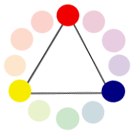
Red, yellow and blue make up the primary colors.
When you look at a professionally produced color wheel for purchase in any art store you could easily be intimidated. After this lesson you will understand the color wheel looks far more complicated than it is. Just think of it as a color coordinated game of Twister. Now lets take this one color wheel section at a time.
Secondary colors (color model shown below) – These are known as those colors achieved by a mixture of two primaries. Example: I believe it was Ziploc who declared in a brilliant preschool fashion that “Yellow and blue make green,” to show how their plastic bags proved they were closed in a testament to color theory basics.
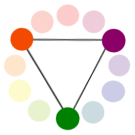
A secondary color wheel is made up of orange, purple and green.
(color model shown below) – These are the colors achieved by a mixture of the secondary colors. Yellow-orange, red-orange, red-purple, blue-purple, blue-green and yellow-green.

Tertiary colors are created from mixing secondary colors.
(color model shown below) – These are the colors that are across from each other on a color wheel. A professor once instructed me to think of holidays: Christmas (green and red), Easter (yellow and purple), Super Bowl (blue and orange -- well, at least was a holiday in Denver that year).
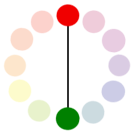
Complementary colors are colors that are directly across from each other on the color wheel.
(color model shown below) – These are the colors that are one hue and two equally spaced from its complement.

A split complementary consists of the colors on either side of a colors complement.
(color model shown below) – These are the colors that equal two complementary color sets.

Take your two favorite complementary color combinations and you have a double complementary color scheme.
(color model shown below) – These are the colors that are located adjacent to each other on a color wheel.
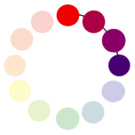
Analogous colors are next door neighbors who get along.
(color model shown below) – These are the colors that are three hues equally positioned on a color wheel.

Double triad is all about equal spacing on the color wheel.
(color model shown below) – So now that we’ve explained the basic color combinations when you come across a color wheel like the shades and tints one shown below you will have a better grasp on how it works. Using this kind of color wheel divided into various shades and tints is one method of easily identifying a multitude of possible option for color schemes.
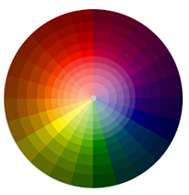
With a shades and tints color wheel it is easy to see the many different color combinations you can achieve, and just think it all started with yellow, red and blue.
Color is our friend, and everything can be traced back to the primaries, remember preschool! If you are still feeling intimidated look to Mother Nature for inspiration. She’s been putting colors together for millenniums and no one has complained yet.



















[...] Now that you know the history and the two different definitions of the color wheel or circle we will explore color further in Part 2: Color wheel relationships and groupings. [...]